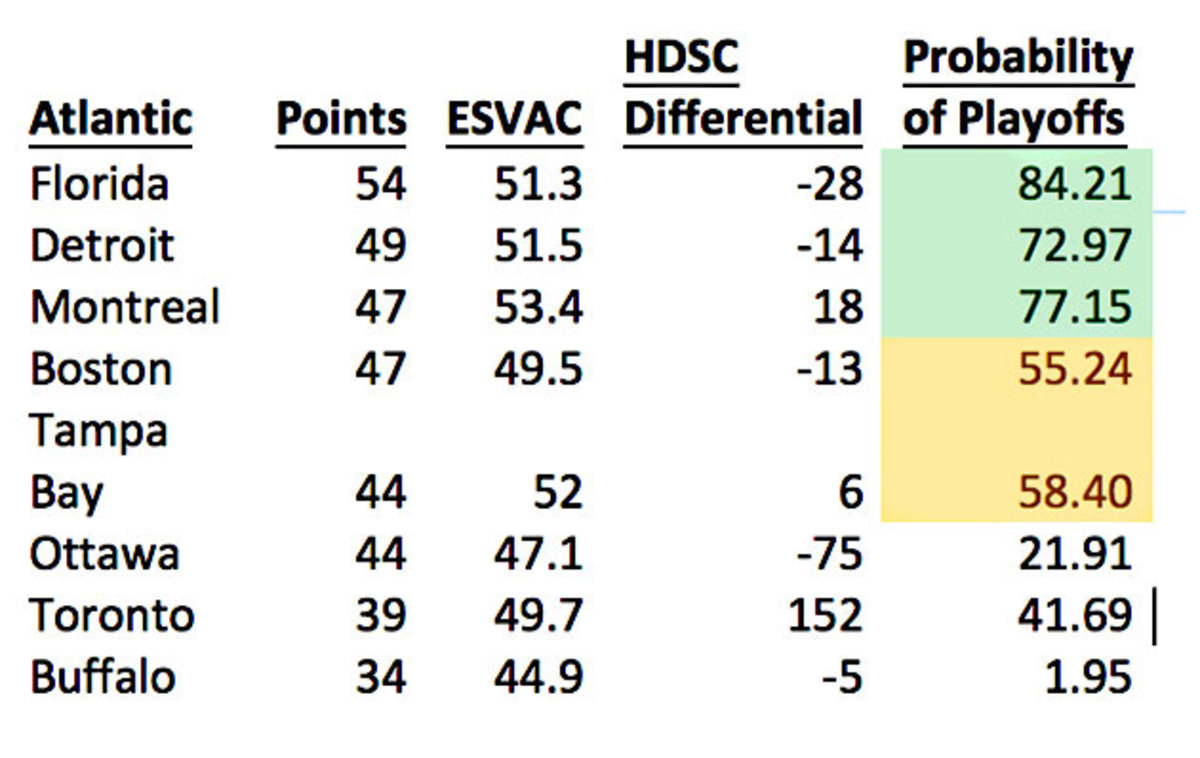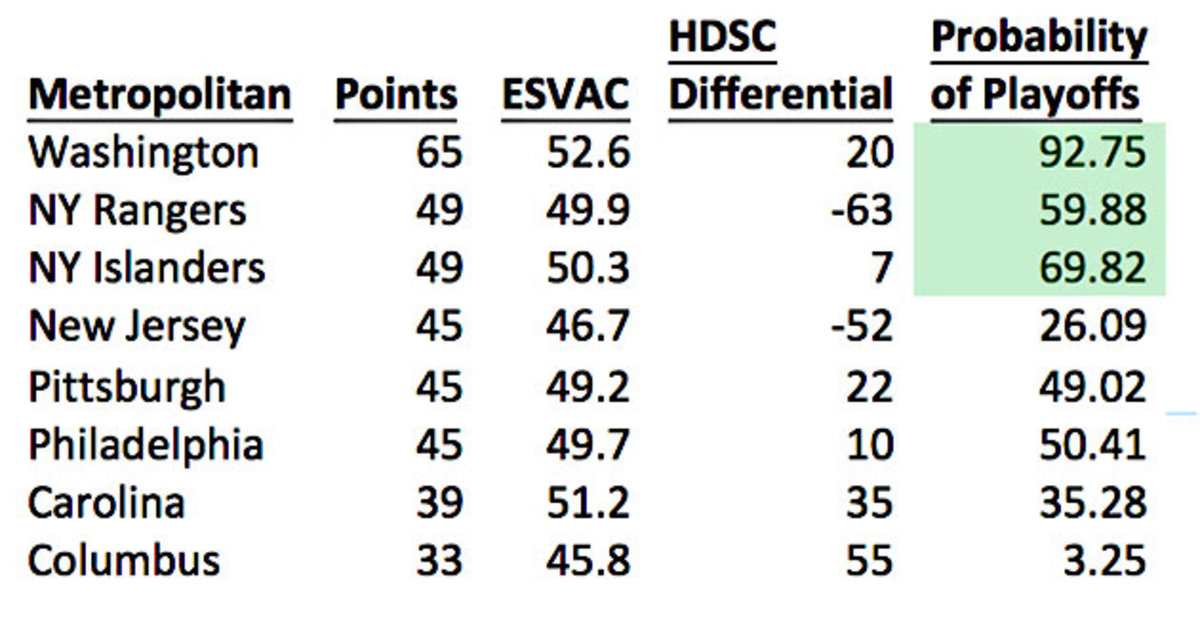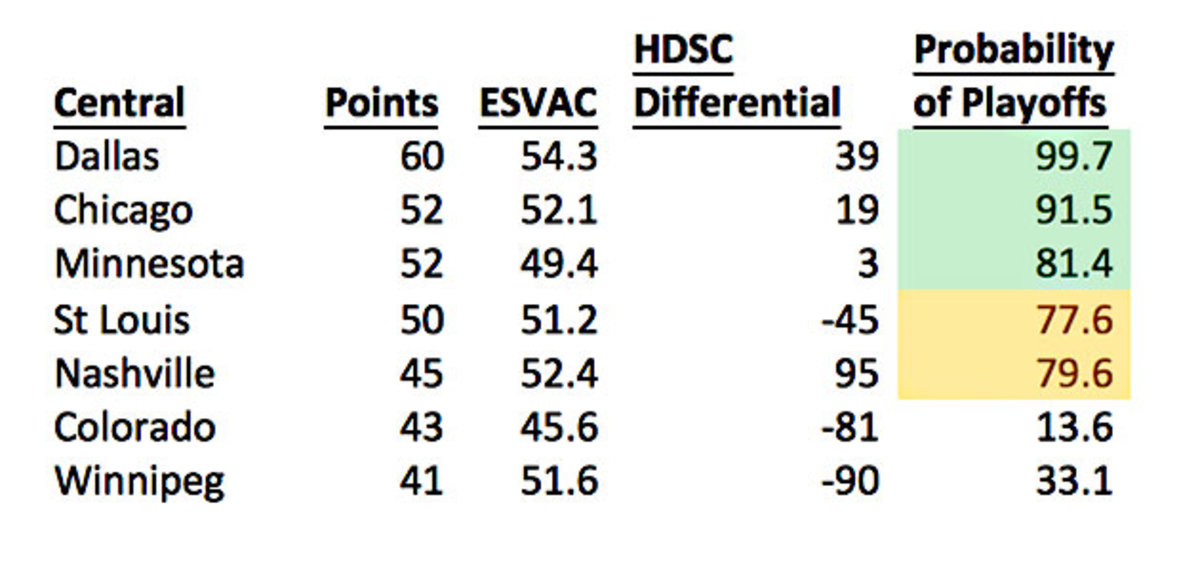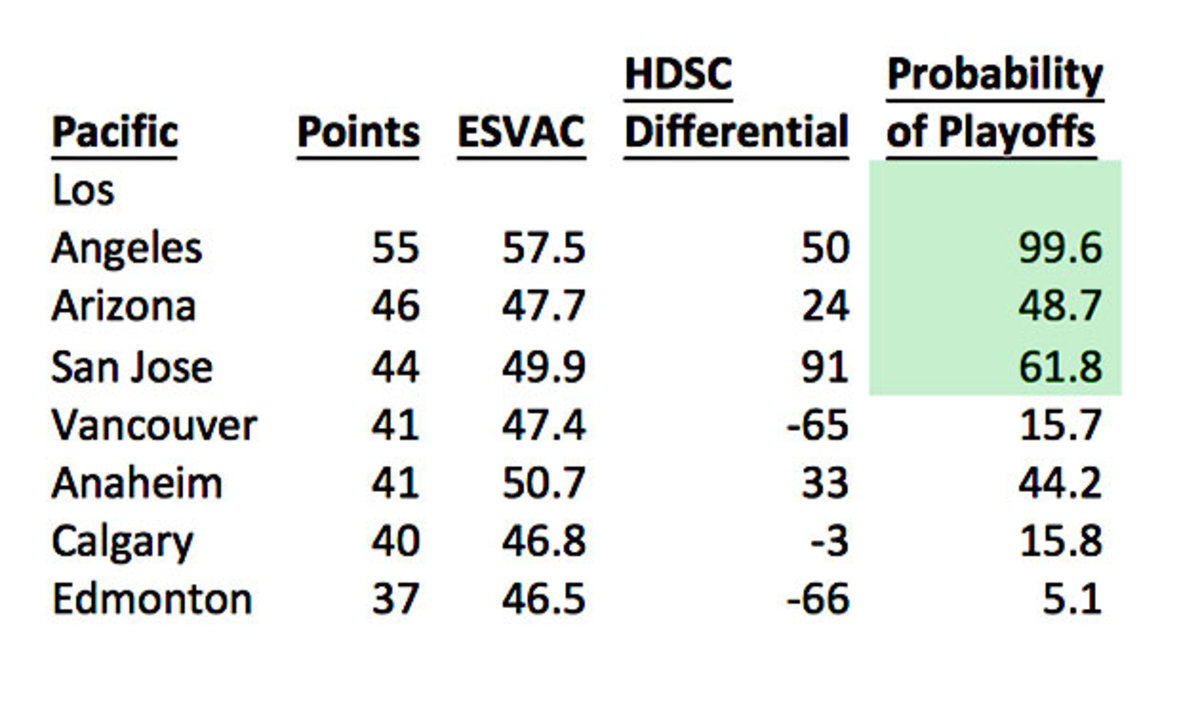Advanced stats predictions for the NHL playoff stretch drive

As of the end of play on January 13th, every team in the NHL had played at least half its schedule. While the playoff picture is starting to take shape, things are far from set in stone.
There are also some interesting stories developing. For example, in the Pacific Division, Arizona has been a huge surprise, as the Coyotes held the second best record in the division through 41 games. On the flip side, Anaheim was a team picked by many as a Stanley Cup favorite, but the Ducks were playing only .500 hockey at the midpoint, although they have been better after a disastrous 1-7-2 start in which they scored only 10 goals. Can Arizona hold on? Can Anaheim pull itself back into a playoff position?
One way to answer these questions is to look at the data that tells us how things have panned out in the past.
The past year has seen a lot of new statistics developed in the world of hockey analytics, meaning that there is more data than ever to use. For example, War-on-Ice.com (soon to be defunct? We sure hope not!) has brought us Scoring Chances and High Danger Scoring Chances as a way of measuring shot quality, while PuckOn.net (based on the work of Micah McCurdy) has developed better ways to account for how the score of a game and the venue (home vs. away) affect the different kinds of shot attempts that make up both Corsi and Fenwick.
So which of these new statistics is worth using to predict which teams will make the playoffs?
First, suppose that you could only look at one stat on which to base your playoff predictions. Should you use Scoring Chances? Event, Score, and Venue Adjusted (ESVA) Corsi? How about more standard stats such as shooting percentage and save percentage?
NHL Roundtable: League’s best player, big bargain, worst team, more
Well, if you could only look at one stat, you might just look at the standings. But the teams that racked up a lot of points in the first half are not necessarily good teams and more likely to excel down the stretch. As it turns out, points in the first half of the season are not a very good predictor of points in the second half. The reason points are predictive at all is that they are what get a team into the playoffs, and how many each has accumulated so far dictates how much of a cushion (or how big of a deficit) each club has.
But why look at just one variable when you can look at many? Those who are familiar with statistical analysis will know that looking at all possible variables isn’t that useful. Sure, you will be able to fit the data better, but you lose a sense of which variables are actually important. The right approach is to balance the temptation to just throw lots of data at a problem against the conceit that one thing will tell you everything you need to know.
So, we settled on a model with three variables: (1) points, (2) ESVA Corsi, and (3) High Danger Scoring Chance Differential (in all situations, not just 5v5).
ESVA Corsi is about as good a measure as we have for determining how well a team dictates the flow of a game. High Danger Scoring Chance Differential gives an indication of how well a team generates quality scoring chances relative to its opponents. It is interesting to note that looking at whether a team does this is actually better at predicting its future performance than looking at its shooting percentage or save percentage (or both in PDO). Finally, as already mentioned, points at the halfway mark add a lot of value in determining whether a team makes the playoffs.
Using these variables, we generated the following predictions for each team’s chances of making the postseason. Note that these predictions are based on how each team was doing after 41 games. All teams have now played more games, but the data we used does not include what happened in those games.




As it turns out, Arizona and Anaheim will be in quite the battle for the third divisional playoff spot out of the Pacific, and our model believes that Arizona has the advantage. Whoever loses that battle had better book some tee times in late April because both wild card spots in the West will go to Central Division teams, with Dallas, Chicago, Minnesota, Nashville and St. Louis all looking very strong. Winnipeg will not be in the mix, as the Jets suffer from their league-worst differential in High Danger Scoring Chances, despite being an above average possession team. They might be driving the play, but they’re not translating it into quality looks at the net and it’s not like goalie Connor Hellebuyck can play any better than he has to date.
In general, the West is pretty much as one might expect. Vancouver isn’t as good as its points total suggests, Dallas and Chicago really are that good, and Nashville fans are cursing the fact that the Predators are not in the Pacific.
Perhaps the biggest surprise is that Avalanche coach Patrick Roy still has a job. Of course, many in the analytics community have been saying this for some time now (including us), but it’s now hard for even his good buddy, former teammate and boss Joe Sakic, to deny that his teams have been anything other than abysmal both at controlling the play and at generating quality scoring chances (relative to their opponents) during his entire tenure—even when they made the playoffs. Roy has been a noted disbeliever of analytics in the past, but maybe it’s time for him to take those Stanley Cup rings out of his ears and start listening.
Players most likely to be dealt before the 2016 NHL trade deadline
In the East, however, things get more interesting. Washington is the best team by far, but not in the class of the top Western teams in terms of controlling play or generating quality scoring chances. There are 10 teams that had between 49 and 44 points after 41 games, and some of them have legitimate playoff chances, while others do not. Two of the top teams in that group, Montreal and the New York Rangers, are clearly disappointed to be bubble teams after their extremely hot starts. Montreal, however, has done much better at the possession game and generating scoring chances. The Habs have been undone partly by goalie Carey Price’s absence, but mostly by cold shooting. Shooting percentage and save percentage, however, have very little predictive power because they bounce around so much, and so our model still likes the Habs’ chances.
That said, keep in mind that our model is based on how similar looking teams have performed, on average, in the past. If you believe Montreal’s not scoring because it has below average scoring talent (something a couple of years worth of scoring leaders data suggests may well be the case) the Habs’ odds could be worse than our model suggests. On the flip side, if you’re a Capitals fan we’ll paint you a nightmare scenario: Price returns sooner rather than later, the Habs hit their stride and secure that second wild card spot and face off against the Presidents' Trophy-winning Caps in the first round.
Having flashbacks to 2010 yet?
The Rangers, on the other hand, are subpar in both driving play and generating quality chances, and seem much more likely to miss the playoffs. Ottawa and New Jersey are the clear pretenders out of this bubble group, but so is Pittsburgh. Perhaps new coach Mike Sullivan can turn things around, but the fact that the Penguins are in this position at all is pretty surprising.
Why trading Phil Kessel makes good sense for the Penguins
Of the teams too far back to be serious playoff contenders, Toronto is a bit of an anomaly. The Maple Leafs have by far the biggest differential in High Danger Scoring Chances—the fourth largest such differential in the past decade—while being only a middling team at driving the play. With some better finishing, and any ability whatsoever to prevent the first shot-against of the game from going in, things could have been quite different, which is a real credit to coach Mike Babcock and the work he’s done there.
Columbus, meanwhile, is Winnipeg’s evil twin. The Blue Jackets have generated better quality chances but seem content to put their middling goaltending into the firing line to the point where it costs them games. And Buffalo, after all of its offseason moves, really hasn’t improved much at all. Clearly, there’s a lot of work still to be done there.
So, while the standings give some indication of the quality of a team, even at the halfway point they clearly don’t tell the whole story. There’s still a lot of hockey left to play, and it will be interesting to see which (if any) teams buck the odds and manage to keep playing after 82 games.
The Department of Hockey Analytics employs advanced statistical methods and innovative approaches to better understand the game of hockey. Its three founders are Ian Cooper (@ian_doha), a lawyer, former player agent and Wharton Business School graduate; Dr. Phil Curry (@phil_doha), a professor of economics at the University of Waterloo; and IJay Palansky (@IJay_doah), a litigator at the law firm of Armstrong Teasdale, former high-stakes professional poker player, and Harvard Law School graduate. Visit us on line at www.depthockeyanalytics.com
